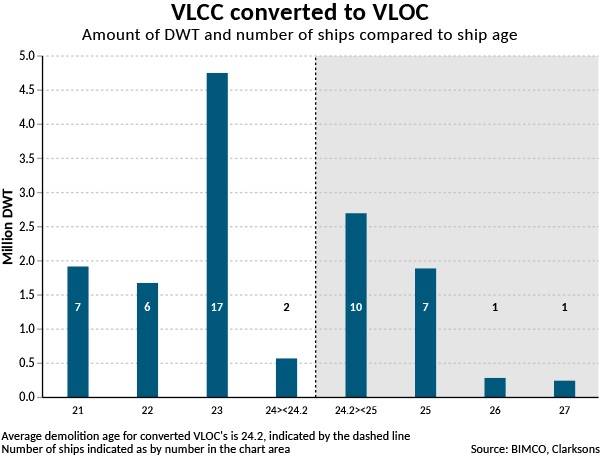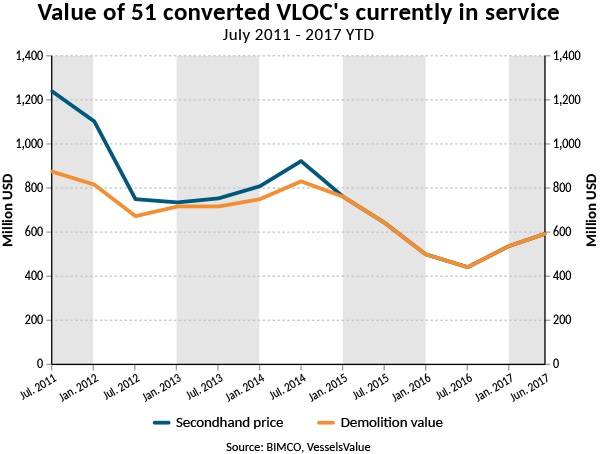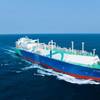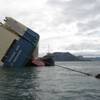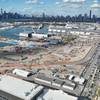With an average age of 23.8 years, the fleet of very large ore carriers (VLOC) converted from very large crude carriers (VLCC) is vintage compared to the average age of 5.7 years for non-converted ore carriers above 200,000 DWT, according to BIMCO.
But despite the huge 18.1 years age gap between converted VLOCs and normal VLOCs, the age itself is not the all-important explanatory factor behind a demolition decision. Naturally safety is a paramount issue, but also the fact that the vessels are still employed on a contract.
“There are few acute purely economic incentives to demolish VLOCs converted from VLCCs despite the comparable high age. Some of the reasons being: still running on time charter contracts and identical prices for demolition and secondhand sale,” said BIMCO’s chief shipping analyst Peter Sand.
“Most of the converted VLOCs are operating profitable on fixed routes and schedules, as they have secured freight rates and employment on long-term time charter contracts long time ago,” Sand said. “This allows them to deliver a positive return on investment where others may fail, despite not being of the most modern ship design around.”
“As the value of a converted VLOC currently in service, is the same in the secondhand market as the demolition market, there is neither an incentive for selling your ship for immediate profits.”
19 of the converted 51 VLOCs are past average demolition age
The average demolition age for the VLOCs converted from VLCCs is 24.2 years and with an average age of 23.8 years, many converted VLOCs are past the demolition age or close to. Currently the converted VLOC fleet capacity consists of 36 percent ships older than 24.2 years, which amounts to 5.1 Mio. DWT. Furthermore, 34 percent or 4.7 Mio. DWT will exceed the average demolition age within the next 12 months.
“The lifespan of a ship depends on a variety of parameters, such as maintenance, general fatigue and the design itself,” said BIMCO’s deputy secretary general Lars Robert Pedersen.
“Without specific knowledge about these parameters it is impossible to draw specific conclusions on the general lifespan or projected life of any ship type.”
Secondhand price and demolition value have merged
Six years ago, the secondhand price for a converted VLOC was 30 percent higher than the demolition value. However, as the earnings for the average capesize ship during large parts of the period between July 2012 to January 2013 plunged below the general OPEX-level of $7,500 per day, the secondhand price fell to a level near demolition value.
Until January 2015 the secondhand price was slightly above the demolition value. As the earnings started to slide in 2015 and continued into 2016, the secondhand price and demolition value merged and have stayed at the same level ever since.
In 2016, four converted VLOCs were demolished, and so far one converted VLOC has been demolished in 2017.
The converted VLOC fleet could carry 26 percent of the Brazil – China iron ore trade
24 percent of the total VLOC fleet is converted from VLCCs, as 51 converted VLOC ships are currently in service, amounting to a total of 14 Mio. DWT compared to a total of 214 Capesize ships above 200,000 DWT classified as ore carriers.
Sand added, “The average size of a converted VLOC is 275,000 DWT. Therefore, if all 51 converted VLOCs were fixed on the route from Tubarao, Brazil to Baoshan, China, they would be able to carry an estimated 1.1 Mio. metric tons of iron ore each, per annum. Thereby, the current batch of converted VLOCs can carry 56 Mio. metric tons of iron ore, if operating on the Brazil to China route. This is equals to 26 percent of the total iron ore trade from Brazil to China in 2016
“In comparison, the existing newbuilding orders for 32 valemax ships (400,000 DWT each), amounts to 12.8 Mio. DWT. This capacity will enter the dry bulk shipping fleet and will be deployed on the Brazil to China route, where they will be able to carry 51.2 Mio. Tonnes of iron ore, per annum on multi-year time charters.
“We highlight this to make the point that the 32 valemax ships, are being built and scheduled for delivery in 2018-2019. At that time, many of the converted VLOCs may still be actively trading. Thus, we do not expect the delivery of the valemax ships into the active fleet to be neutralized by immediate or simultaneous demolition of the converted VLOC fleet.”





